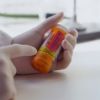Article
Long-Term Tenofovir Disoproxil Fumarate Treatment Well Tolerated in Hepatitis B
Author(s):
Sustained viral response (SVR) without resistance or safety issues was reported among chronic hepatitis B (HBV) patients taking tenofovir disopoxil fumarate (TDF) therapy over a 7-year period.

During a poster session at the 2013 annual conference of the American Association for the Study of Liver Disease, held November 1-5 in Washington, DC, Patrick Marcellin, MD, PhD, a professor of hepatology at the University of Paris and the head of the Viral Hepatitis Research Unit at the l’Hôpital Beaujon in Clichy, France, reported sustained viral response (SVR) without resistance or safety issues among chronic hepatitis B (HBV) patients taking tenofovir disoproxil fumarate (TDF) therapy over a 7-year period.
Marcellin’s study built on previously reported trial data that showed similar sustained virologic suppression, favorable safety and tolerability, and a lack of resistance after 6 years of treatment. Additionally, TDF treatment has been associated with regression of liver fibrosis — defined as improvement or no worsening — in 96% of HBV subjects, as well as eradication of signs of cirrhosis in 74% of patients after 5 years of therapy.
The researchers first reported virologic suppression — defined as serum HBV DNA <400 copies/mL — in year 7 among both intent-to-treat (ITT) patients and individuals on treatment.
In HBeAg- patients, virologic suppression was seen in 77.3% of the 348 patients using ITT and 99.3% of the 273 patients on treatment. Those figures were slightly lower than the year 6 figures of 81.4% in the ITT group and 99.6% in the treatment group.
For HBeAg+ patients, 60.3% of the ITT group showed viral suppression, compared to 99.4% of the treatment group. Again, those numbers depicted a slight decline from the year 6 data, which showed 62.5% viral suppression in the ITT group and 98.8% in the treatment group.
Biochemical response was measured using alanine aminotransferase (ALT) normalization. For HBeAg- patients, ALT normalization was seen in 64.6% of the ITT patients and 83.5% of the treatment patients. However, lower biochemical response rates were seen in HBeAg+ study subjects, as ALT normalization occurred in only 46.9% of patients using ITT and 74.2% of patients on treatment. Small declines were again seen in the transition to the study’s 7th year, given that ALT normalization figures for year 6 were 50.6% for ITT and 78.4% for treatment.
Serologic response was measured for the subset of HBeAg+ patients at baseline. HBeAg loss was reported in 55% of evaluable patients at year 7, and HBeAg seroconversion occurred in 40% of patients, the researchers said.
According to the poster authors, no resistance to TDF was detected over the 7-year study period. Additionally, genotyping in a limited subset of patients showed no conserved site changes throughout the 7th year, and only 1 previously identified polymorphic site change was shown to be sensitive to TDF.
In the study’s open-label period that began after year 1, a total of 2.2% of participants discontinued the drug due to adverse events (AEs). The sum of grade 3 and 4 study-related AEs was 6 (1%). Seven (1.2%) serious study-related AEs occurred, and death occurred in 12 patients (2.1%). Clinically significant elevations in serum creatinine over baseline — as well as hypophosphatemia and clinically significant reduced creatinine clearance — occurred in less than 2% of the study population. Overall, safety and tolerability profiles were reported to be good.



